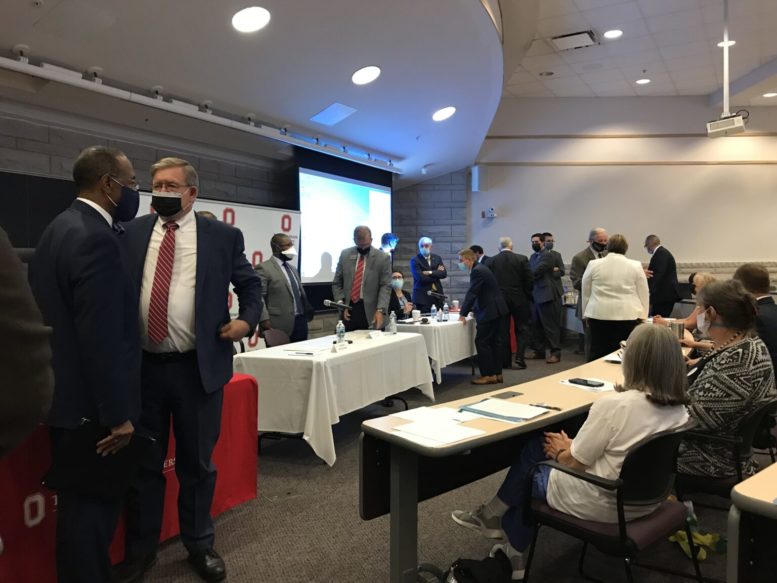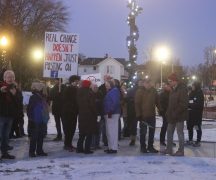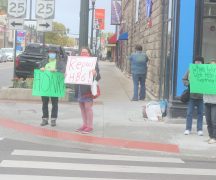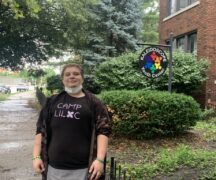Commission members say no secret meetings happening
BY SUSAN TEBBEN
Members of the Ohio Redistricting Commission ended their week in Mansfield as constituents continued to give input on legislative district map-drawing, and share their thoughts on the process.

Throughout the week of two-a-day meetings, starting in Clevelandand winding through the state to Youngstown, Dayton, Cincinnati, Zanesville, Rio Grande, Lima, Toledo, Akron and Mansfield, commission members and/or their designees heard many stories of split districts, split houses and neighbors wanting their communities to be whole within voting districts.
“I’m here because this year we have the opportunity, indeed the obligation, to establish a stronger, fairer foundation for the next 10 years,” Bexley resident Meryl Neiman said at the Mansfield public hearing held Friday afternoon.
A handful of participants denied that gerrymandering was a problem in the state, saying Republican dominance in the state was an indication that voters had made their decisions, not that districts were drawn to favor GOP candidates over full representation.
But as the process moves on to map-drawing and at least three constitutionally required public hearings after the maps are proposed, Ohioans are even more focused on the transparency they say was built into a ballot initiative that changed the way redistricting would work in the state and was passed by voters with overwhelming majorities to combat gerrymandering.
No secret meetings, say commission members
Speakers throughout the week were concerned about members of the commission or their staff meeting in private, namely drawing maps that favor one side. The concerns stemmed from the 2011 redistricting effort, which didn’t have the same rules as are now in place via the ballot initiative, and was lambasted as a secretive process done without public input.
Those concerns are also unfounded, according to members of the current redistricting commission. Secretary of State Frank LaRose told the OCJ on Thursday that conversations should be going on about redistricting all over the state, but nefarious meetings to push particular district lines have not been happening.

Photo by Susan Tebben
“It’s a fantasy,” he said. “It’s just not happening.”
The secretary of state likened accusations of closed-door hearings with commission members or their staff to “conspiracy theories” made about election integrity.
“I’ve not been in any meetings that are going on about this,” LaRose said. “People with maybe overactive imaginations envision some sort of secretive cabal, it’s just not reality.”
LaRose was not alone in denying existence of behind-closed-doors meetings regarding redistricting. Previously, Auditor Keith Faber denied any meetings occurring when asked by the OCJ after the Zanesville public hearing.
House speaker and commission co-chair Bob Cupp also said he hasn’t participated in any meetings other than those that “follow the rules.”
“Obviously we talk to staff, our staff is is working on it, trying to get this process going,” Cupp told the OCJ on Thursday after the Lima public hearing. “In terms of a commission group or a caucus of the commission getting together to talk about it, we haven’t done it.”
Senate President Matt Huffman’s spokesperson, John Fortney, called the claims of secret meetings “the same old shallow accusations we’ve become accustomed to hearing from the former chair of the Ohio Democratic Party,” referring to David Pepper, who was one of the people asking about the claim at the Cincinnati public hearing.
“For us, the work will be done in state office space where the process can be uninterrupted and completed without further delay based on the census being four months late,” Fortney said.
The two Democrats on the Redistricting Commission called for adoption of rules and bringing a map forward for review by the public as soon as possible. House Minority Leader Emilia Sykes spoke up at the Lima meeting, asking for a plan on introducing a map proposal.
“I think it would be helpful for us as we navigate the remainder of this process and these deadlines to start that discussion,” Sykes said.
Commission co-chair Vernon Sykes, who was the only commission member to attend all 10 public hearings this week, said more public discussion is necessary dealing with maps.
“I don’t believe this should be handled as we do with the budget with the conference committee report that comes out in just enough time to announce what the results are,” Vernon Sykes said in the Lima public hearing.
The committee was set to vote on commission rules, rules that set schedules and procedures going forward for presenting and approving maps, last week, but the vote was held up because bipartisan agreement came up short, according to commission members.
Cupp said the commission was trying to reach a bipartisan consensus on rules, “but I don’t think we’re there quite yet.”
Vernon Sykes said the hold up with the rules “is really when and how we’re going to have maps disclosed or maps being reviewed or considered by this body.”
One thing that has support on both sides of the aisle is having more public input. At least three hearings are required after maps are presented, for which the first deadline is Sept. 1.
“I think most of us are committed to having multiple hearings on maps regardless of whether the September 1st deadline can be met,” Cupp told meeting participants in Lima.
If the commission doesn’t agree to a map in the first go-round, at least one additional hearing is required for a map that would be subject to simple majority vote by the commission.
Organizations push forward with proposed maps

Now that U.S. Census Bureau data is available to the state for the purpose of map-drawing, organizations who have been eagerly awaiting starting that process have begun submitting proposed maps they hope will be considered by the commission.
The Ohio Citizens Redistricting Commission, a coalition of Ohioans separate from the official Ohio Redistricting Commission, released “unity maps” which they say reflect how Ohioans vote, rather than political majority.
The citizens commission’s maps propose 12 “minority opportunity districts” for the Ohio House and four for the Senate. Those districts would have a Black voting age population of at least 30%.
As of now, nine proposed legislative maps have been submitted on the Ohio Redistricting Commission’s website, and 19 congressional maps have been submitted on the website for public and commission review.
***
Also from Ohio Capital Journal:
Judge orders Cincinnati hospital to treat COVID-19 patient with Ivermectin, despite CDC warnings: Doctor calls Ivermectin’s advocates ‘snake oil salesmen’
A Butler County judge ruled in favor of a woman last week who sought to force a hospital to administer Ivermectin — an animal dewormer that federal regulators have warned against using in COVID-19 patients — to her husband after several weeks in the ICU with the disease.
Butler County Common Pleas Judge Gregory Howard ordered West Chester Hospital, part of the University of Cincinnati network, to treat Jeffrey Smith, 51, with Ivermectin. The order, filed Aug. 23, compels the hospital to provide Smith with 30mg of Ivermectin daily for three weeks.
The drug was originally developed to deworm livestock animals before doctors began using it against parasitic diseases among humans. Several researchers won a Nobel Prize in 2015 for establishing its efficacy in humans. It’s used to treat head lice, onchocerciasis (river blindness) and others.
Both the U.S. Food and Drug Administration and the Centers for Disease Control and Prevention have warned Americans against the use of Ivermectin to treat COVID-19, a viral disease. It’s unproven as a treatment, they say, and large doses of it can be dangerous and cause serious harm. A review of available literature conducted earlier this month by the journal Nature found there’s no certainty in the available data on potential benefits of Ivermectin. READ MORE
World science community watching as natural gas-hydrogen power plant comes to Hannibal, Ohio
There are not a lot of people living in Hannibal, Ohio. It is a tiny port stop on the Ohio River, with just 1,000 people living in Ohio Township, and just about 14,000 in Monroe County. About 35 miles upstream is Wheeling, West Virginia, and about 45 miles downstream is Marietta, Ohio.
But this tiny place in what is considered the Appalachian part of Ohio, a new power plant that is gaining the notice of the scientific world is about to open here at the end of August. Long Ridge Energy, which sits on 1,600 acres of property where an aluminum smelter closed about a decade ago, will be producing electricity that will mix natural gas and hydrogen as the power source.
Hydrogen is being “rediscovered” as a environmentally friendly energy source, though it is more simple than complicated: It is the simplest and most abundant element on earth, consisting of only one proton and one electron. But there is a catch. It doesn’t typically exist by itself in nature and must be produced from compounds that contain it.
“What we are doing is very important to the renewable energy industry, and we have somewhat flown under the radar as to being a leader in some big changes that are coming for the energy industry,” Robert “Bo” Wholey, the president of Long Ridge Energy and Pittsburgh native, said to Ohio Capital Journal. READ MORE





